Think hyperbaric oxygen therapy (HBOT) is just for hospitals? Think again. Home hyperbaric chambers are making this powerful therapy more accessible than ever, with over 18,000 portable units currently in use worldwide. [1]
But what exactly is HBOT, and why are so many people bringing this technology home?
What is Hyperbaric Oxygen Therapy?
In simple terms, HBOT involves breathing nearly pure oxygen in a pressurized chamber. The increased pressure helps your lungs gather more oxygen, which then dissolves into your blood plasma and other body fluids.
This oxygen-rich environment = enhanced healing potential at the cellular level.
Why Choose a Home Hyperbaric Chamber?
The benefits driving home adoption include:
- Enhanced Recovery: Accelerated healing from sports injuries, wounds, and general recovery
- Improved Circulation: Better oxygen delivery throughout the body
- Cognitive Benefits: Potential improvements in brain function and memory
- Convenience: Treatment on your schedule without clinic visits
- Long-term Cost Savings: Avoid repeated clinical session fees
- Family Use: Multiple household members can benefit
“But is it safe to use at home?”
Great question! While home chambers operate at lower pressures than clinical units, they still require proper understanding and safety protocols.
CRUCIAL DISCLAIMER: Always consult with a healthcare professional before starting HBOT. This article provides general information, not medical advice. Your doctor can determine if HBOT is appropriate for your specific health situation and guide proper usage.
How We Picked the Best Home Hyperbaric Chambers
We didn’t just pick these chambers randomly – we used specific criteria to identify the top performers:
- Safety Features topped our list. We prioritized chambers with robust safety mechanisms including multiple pressure release valves, emergency depressurization systems, internal/external gauges, and medical-grade materials.
- Operating Pressure matters for home use. Most home chambers operate at 1.3 to 1.5 ATA (mild HBOT), which is safe for home use while still providing therapeutic benefits.
- Ease of Use & Setup was essential. Nobody wants a complex installation. We looked for chambers with straightforward assembly, user-friendly zippers, and clear operating instructions.
- Size & Comfort varies by need. We included options for lying down or sitting, different diameters for space requirements, and comfort features like viewing windows and quality mattresses.
- Manufacturer Reputation counted heavily. We focused on established brands like OxyHealth (with over 20 years experience), Summit to Sea (with FDA clearance), and Oxygen Health Systems (with ISO certifications).
- Key Inclusions like oxygen concentrators and dehumidifiers add value when bundled with the chamber.
- User Feedback from real owners provided insights into long-term satisfaction and performance.
KEY TERMS YOU SHOULD KNOW
- ATA (Atmospheres Absolute): Pressure measurement. 1.3 ATA = 30% above normal atmospheric pressure
- Soft vs. Hard Shell: Soft chambers are inflatable and portable; hard chambers are rigid structures
- LPM (Liters Per Minute): Oxygen concentrator output rating. 10 LPM is standard for home use
Top 5 Hyperbaric Chambers for Home Use
Explore detailed specifications, features, and pricing for the top 5 home hyperbaric oxygen therapy chambers with interactive product cards.
1. OxyAir 32-Inch or 36-Inch Soft Chamber (by Oxygen Health Systems) – 1.3 to 1.4 ATA
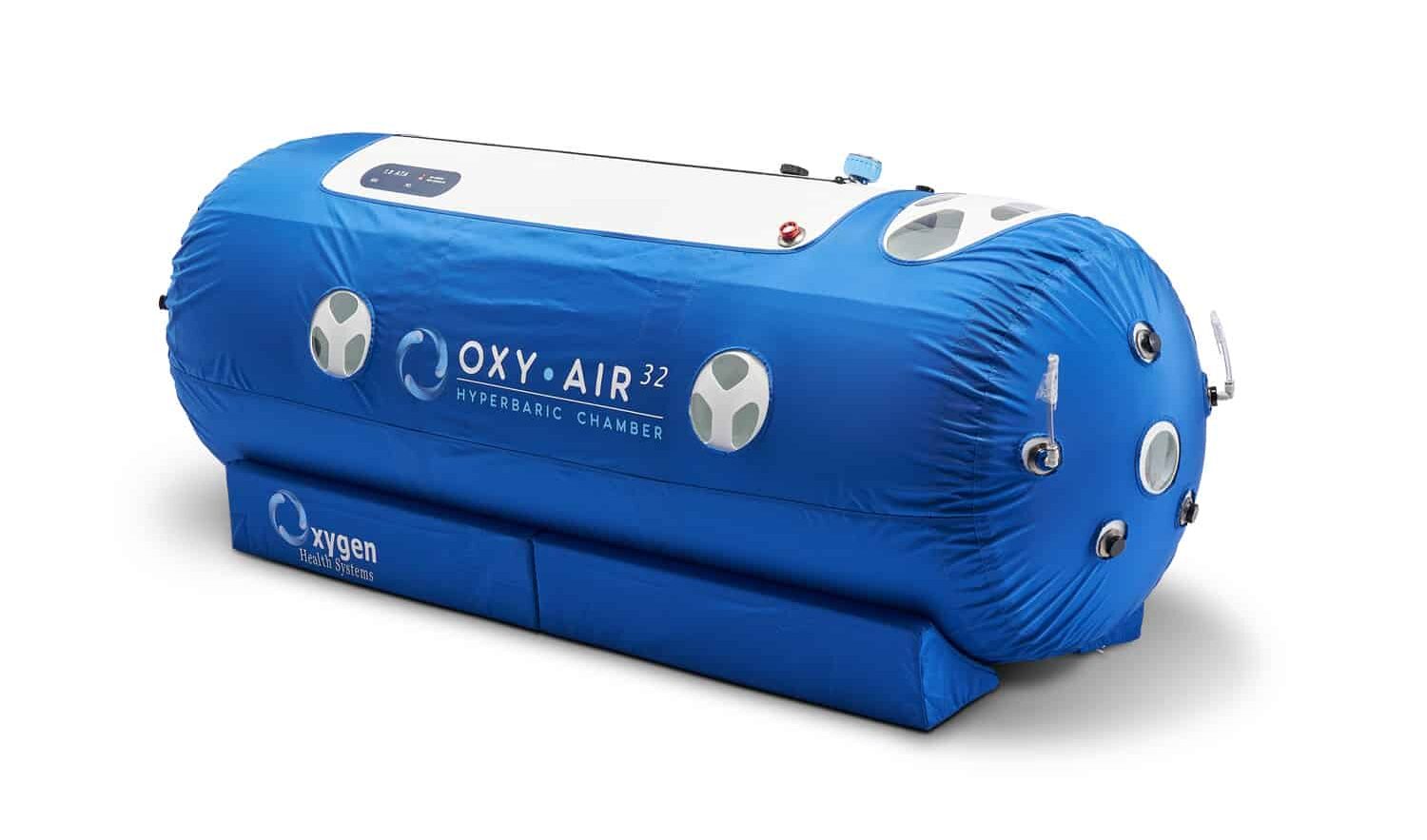
Why it’s good for home use: The OxyAir series offers versatile solutions with medical-grade components and comprehensive safety features, including FDA-approved oxygen concentrators and multiple pressure relief systems. The 36-inch model provides extra room for taller users or those wanting more space.
Specifications:
- Diameter: 32″ or 36″ options
- Pressure: 1.3 ATA standard, 1.4 ATA optional upgrade
- Length: Standard lying chamber length
- Materials: Medical-grade TPU with polyester reinforcement, triple-welded seams
- Viewing Windows: Seven double-deck windows
- Oxygen System: FDA-approved DeVilbiss 10 LPM concentrator producing 95-96% oxygen purity
What’s Included:
- Chamber with internal/external pressure gauges
- 10 LPM oxygen concentrator
- Dehumidifier (saves $700+ value)
- Air cooling system
- Emergency pressure release valve
- Negative ionizer system
Pros:
- ISO 9001, ISO 14001, and ISO 13485 certified manufacturing
- Rated to last 39 years with typical usage (1 hour/day, 5 days/week)
- Multiple safety redundancies
- Spacious 36″ option accommodates larger users
- Comprehensive accessory package
- Self-operable design
Cons:
- Higher price point than basic models
- Requires dedicated space for setup
- May be overwhelming for first-time users
Price Range: $9,690 – $11,539 (varies by size and pressure options)
Who it’s best for: Serious wellness enthusiasts, athletes, or families wanting a premium home HBOT experience with room to grow.
2. OXYFLOW MINI Sitting Hyperbaric Oxygen Chamber (by Oxygen Health Systems) – 1.3 to 1.4 ATA
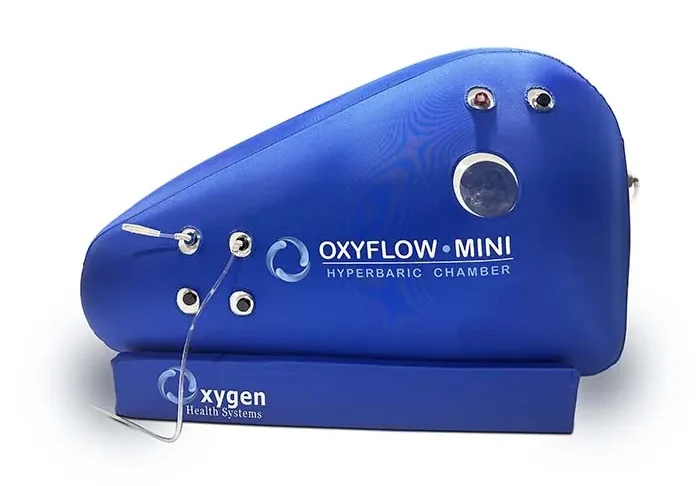
Why it’s good for home use: Ideal for users preferring upright or reclined positions, this chamber features a unique angled design with front entry and only an 8-inch step-in height. Perfect for those who find traditional lying chambers uncomfortable or challenging to enter.
Specifications:
- Dimensions: 73″ long × 44.8″ tall × 42″ wide
- Entry: Front zipper extending toward feet
- Weight: 30 lbs when deflated
- Pressure: 1.3 ATA, 1.4 ATA, or 1.5 ATA options
- Chair: Proprietary adjustable chair (lying flat to 90° upright), supports up to 330 lbs
What’s Included:
- 10 LPM oxygen generator producing 95-96% oxygen purity at 18-20 PSIG
- Dehumidifier
- Air cooling system
- Adjustable reclining chair
- External frame option available
Pros:
- Accommodates users up to 71 inches tall with leg stretching room
- Easy front entry vs. top entry chambers
- Chair adjusts from flat to upright
- Meets ISO 9001, ISO 14001, and ISO 13485 certifications
- 3-year warranty with lifetime customer support
- Lighter weight for portability
Cons:
- More expensive than basic lying chambers
- Limited to single user
- May feel cramped for larger individuals
Price Range: $9,890 – $14,900 (varies by pressure level and frame option)
Who it’s best for: Users with mobility challenges, those preferring to sit during treatment, or anyone wanting flexibility between sitting and lying positions.
3. Summit to Sea Shallow Dive Hyperbaric Chamber – 1.3 ATA
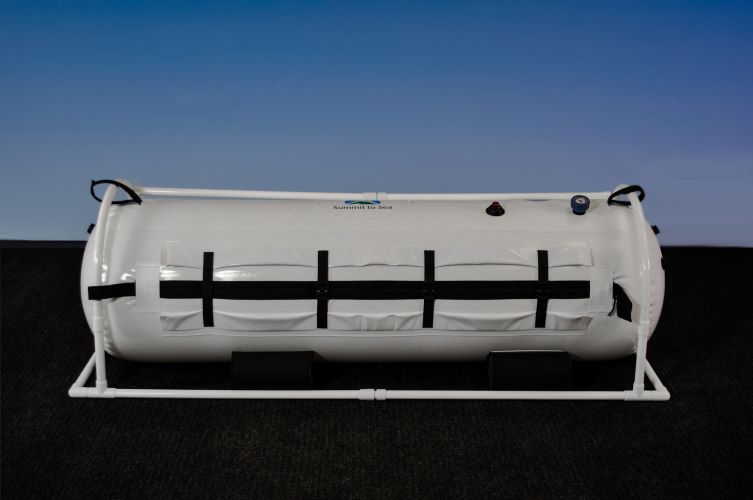
Why it’s good for home use: Quite possibly the best quality and safest soft chamber on the market, with over 30 years of Class II chamber manufacturing experience. FDA-approved with a proven track record and 2-5 year warranty options.
Specifications:
- Size: Compact single-person design
- Pressure: 1.3 ATA
- Materials: Translucent material for bright, airy interior
- Entry: Double-sided full-length zippers operable from inside or outside
- Compressors: Dual high-efficiency electric pumps with patented sound suppression
What’s Included:
- Chamber with external frame
- Carrying case
- Sound-suppressed air pumps with in-line filtration
- 2-year warranty (extended options available)
Pros:
- FDA clearance validates safety and efficacy
- Made in USA with high-quality materials ensuring durability
- Patented sound suppression keeps noise under 50 decibels
- Large viewing windows reduce claustrophobia
- Entry-level pricing
- Military, first responder, and police discounts available
Cons:
- Requires doctor’s prescription (telemedicine consultations available)
- Smaller interior than premium models
- Basic accessory package
- No oxygen concentrator included
Price Range: Contact manufacturer for current pricing (typically entry-level)
Who it’s best for: Budget-conscious buyers seeking FDA-cleared reliability, first-time users, or those wanting proven quality without premium features.
4. Summit to Sea Dive (33-inch) Hyperbaric Chamber – 1.3 ATA
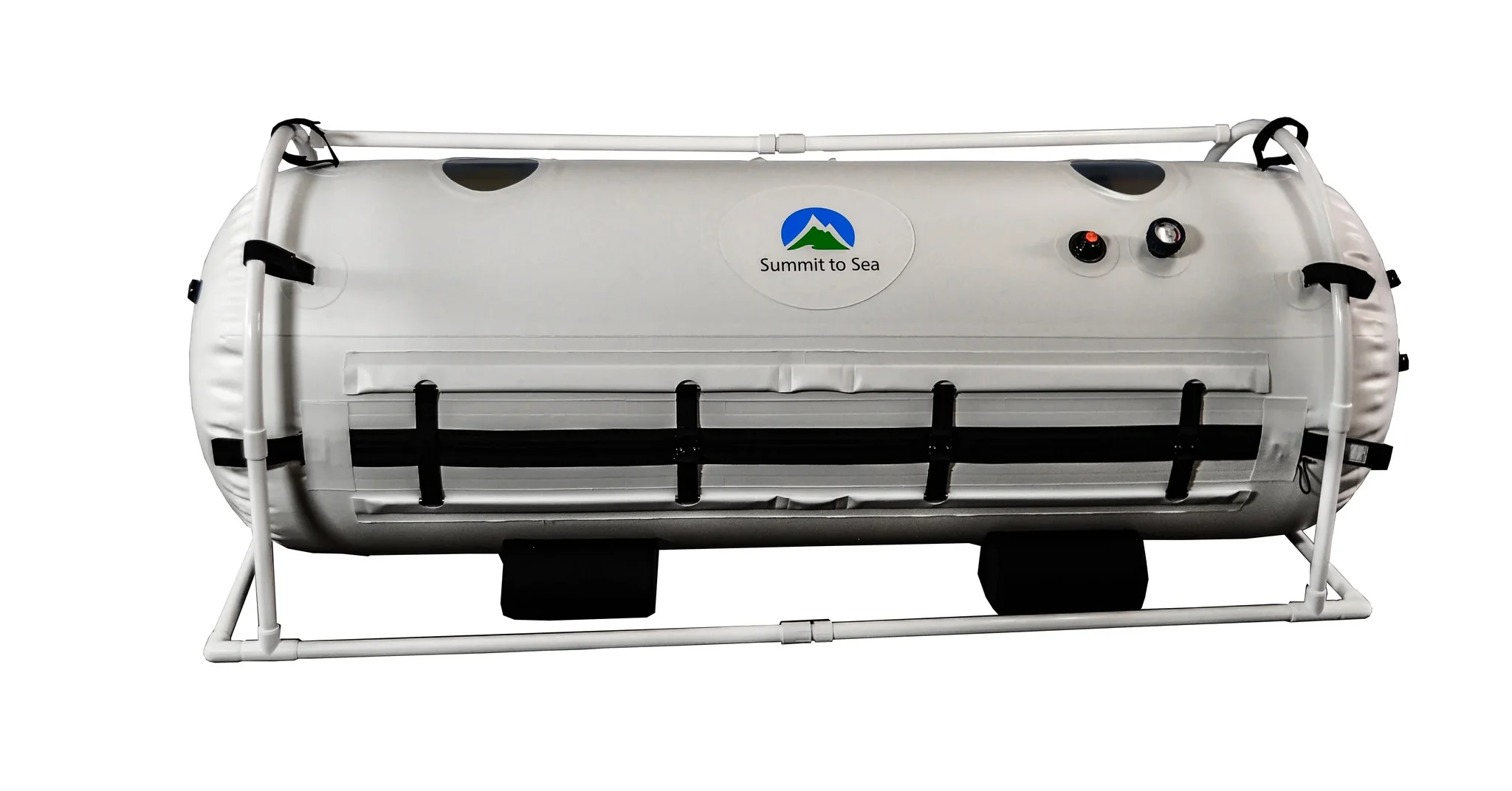
Why it’s good for home use: Summit to Sea’s flagship model offering a roomier experience than the Shallow Dive while maintaining portability, with 33-inch diameter and 90-inch length. Well-suited for home users and athletes with multiple control valves and efficient compressors.
Specifications:
- Dimensions: 90″ length × 33″ diameter
- Pressure: 1.3 ATA
- Entry: Double-sided full-length zippers for easy access
- Compressors: Dual compressors for quick pressurization and safety redundancy
- Interior: White interior with two viewing windows for non-claustrophobic atmosphere
What’s Included:
- External frame
- Carrying case
- Sound-suppressed electric air pumps with in-line filtration
- 2-year warranty
Pros:
- Over 30 years manufacturing experience with quality assurance
- FDA clearance for safety validation
- More spacious than Shallow Dive
- Bright interior reduces claustrophobia
- Dual compressor safety
- Made in USA
Cons:
- Requires prescription (telemedicine available)
- Oxygen concentrator sold separately
- Higher cost than Shallow Dive
- Larger footprint requires more space
Price Range: Contact manufacturer (mid-range pricing)
Who it’s best for: Users wanting more space than entry models, athletes needing regular sessions, or families planning shared usage.
5. LUX-AIR 36-Inch Soft Hyperbaric Oxygen Chamber – 1.3 to 1.4 ATA
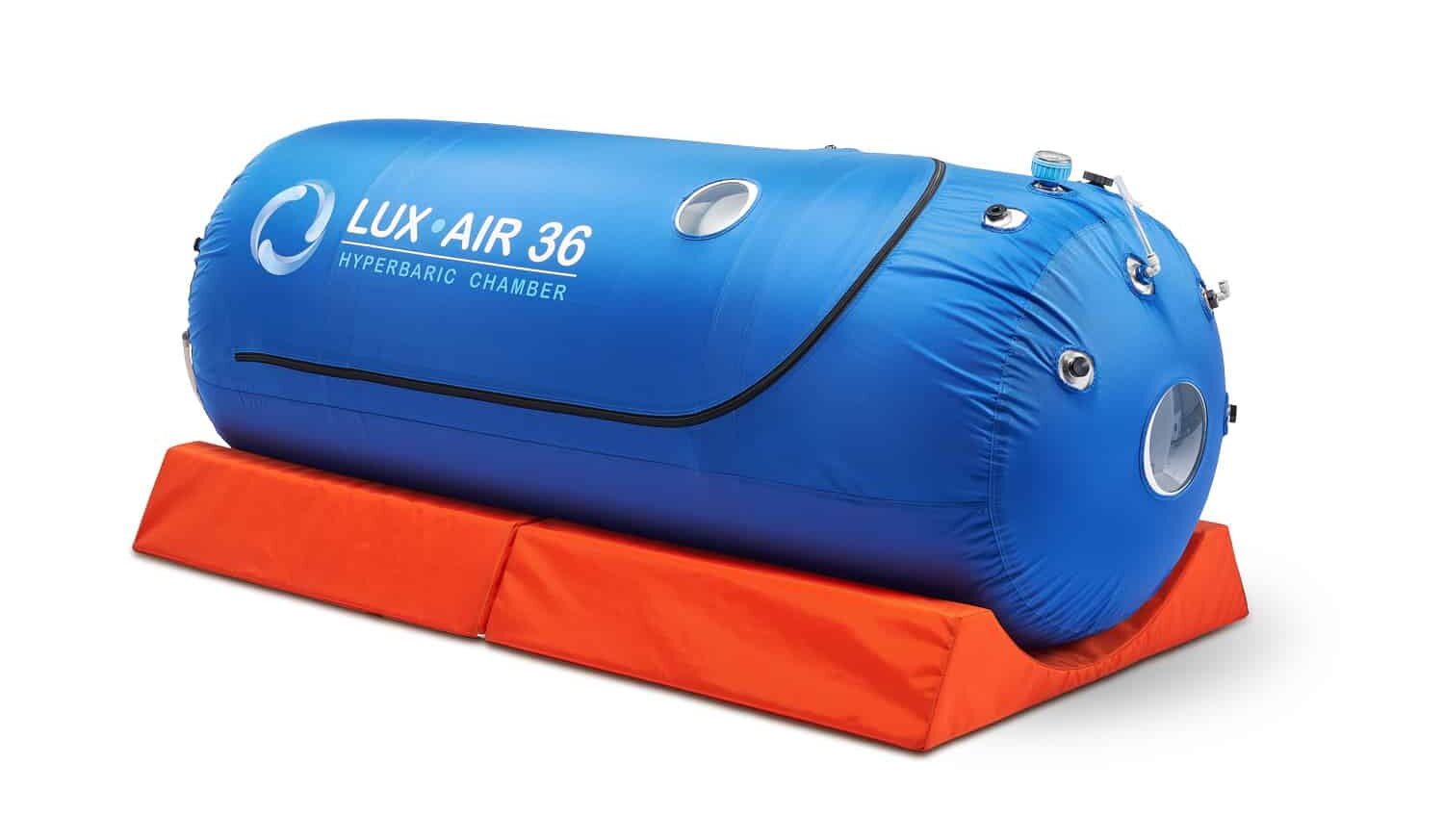
Why it’s good for home use: Features a unique J-style zipper for significantly easier entry and exit, ideal for users with mobility concerns or joint replacements who can’t get on their knees. Can be used as side entry or top entry by rotating the chamber.
Specifications:
- Diameter: 36 inches (spacious for 1-2 people)
- Entry: J-style zipper design with exceptionally wide door
- Pressure: 1.3 ATA standard, 1.4 ATA upgrade available
- Platform: Includes 16-inch elevation platform
- Materials: Medical-grade 3-layer PET Polyester/TPU with triple-welded seams
What’s Included:
- FDA-approved 10 LPM oxygen generator
- Dehumidifier ($700 value)
- Contoured mattress with flat comfort top
- Air conditioning system option
- Internal steel frame, LED lighting, communication system
- 3-year warranty
Pros:
- Revolutionary J-style entry = unparalleled ease of access
- Dual zipper system with center flap prevents leaks
- Can accommodate two people (adult + child)
- Made to last 25-30 years with proper usage
- ISO 9001, ISO 14001, and ISO 13485 certified
- Side or top entry flexibility
Cons:
- Premium pricing
- Larger footprint
- Complex feature set may overwhelm beginners
- AC system additional cost
Price Range: Contact manufacturer for current pricing (premium tier)
Who it’s best for: Users with mobility challenges, families wanting shared use, or anyone prioritizing ease of entry/exit above all else.
How To Choose The Right Home Hyperbaric Chamber
Before diving in, ask yourself: What do you hope to achieve? Recovery from injuries? Enhanced athletic performance? General wellness? Anti-aging benefits? Your goals influence which features matter most.
Soft Shell vs. Hard Shell Chambers: The Real Deal
Soft Shell Chambers (featured in our top 5):
- Pros: Portable, lower cost, easier installation, suitable for home use
- Cons: Lower maximum pressure, may feel less sturdy
- Best for: Home users, first-time buyers, those wanting portability
Hard Shell Chambers:
- Pros: Higher pressures possible, more clinical feel, extremely durable
- Cons: Much higher cost, permanent installation, requires more space
- Best for: Clinical settings, serious medical applications
(Ed. note: For home use, soft shell chambers offer the best balance of effectiveness, convenience, and cost.)
Understanding Pressure (ATA): How Much Do You Need?
Home chambers typically operate at 1.3-1.5 ATA, which provides 30-50% more oxygen than normal air pressure. Higher isn’t always better for home use – it’s about consistent, safe treatment.
- 1.3 ATA: Standard home pressure, proven effective
- 1.4 ATA: 35% pressure increase, shorter treatment times
- 1.5 ATA: Maximum recommended for home use
Size & Space Considerations
Chamber Diameter Options:
- 32″: Compact, fits most users comfortably
- 36″: Extra room, accommodates larger users or two people
- 40″: Spacious, premium comfort level
Space Requirements: Most chambers need 8-10 feet of length and 4-5 feet of width when inflated. Don’t forget ceiling height for entry!
Essential Safety Features to Look For
Never compromise on safety. Look for:
- Dual pressure relief valves and emergency release buttons
- Internal and external pressure gauges
- Medical-grade materials with proper certifications (ISO standards)
- Multiple viewing windows
- Redundant compressor systems
Budget: Balancing Cost with Quality
Entry Level ($8,000-$12,000): Basic chambers with essential features Mid-Range ($12,000-$18,000): Enhanced comfort and safety features Premium ($18,000+): Top-tier materials, advanced features, maximum comfort
Remember: This is a long-term investment. Quality chambers are rated to last decades with proper care.
Specific Chamber Recommendations Based on Needs:
- For Maximum Internal Space & Ease of Entry: LUX-AIR 36-Inch with its J-style zipper revolutionizes accessibility, or OxyAir 36-Inch for generous room.
- For Seated Comfort and Convenience: OXYFLOW MINI is purpose-built for sitting/reclining comfort with adjustable positioning.
- For Balanced Features and Reliability: Summit to Sea Dive (33-inch) or OxyAir 32-Inch provide solid all-around performance.
- For Budget-Conscious Quality: Summit to Sea Shallow Dive offers FDA-cleared reliability at entry-level pricing.
- For Families or Shared Use: LUX-AIR 36-Inch accommodates two people, or OxyAir 36-Inch for spacious single use.
Beyond the Purchase Price – Understanding Long-Term Ownership & Practicalities
Ongoing Operational Costs
- Electricity Consumption: Most chambers use 520-640 watt compressors, roughly equivalent to running a small microwave. Expect $20-40 monthly electricity costs with regular use.
- Oxygen Source: If using an oxygen concentrator (recommended), these typically consume 300-600 watts. Tank oxygen is possible but less convenient for home use.
- Consumables & Replacement Parts: Air filters need periodic replacement ($20-50 annually), seals may need service after years of use, and mattresses/cushions experience normal wear.
Maintenance Routine
- Weekly: Basic cleaning, visual inspection of seals and zippers
- Monthly: Filter replacement, pressure system check
- Annually: Professional inspection recommended for warranty compliance
Most chambers are designed for minimal maintenance – that’s the beauty of quality engineering.
Noise Levels
Modern chambers use patented sound suppression technology, keeping noise below 50 decibels = about as loud as moderate rainfall. You can easily watch TV or listen to music during treatment.
Learning Curve & Usability
Setup time varies: 15-30 minutes for first-time assembly, then 5-10 minutes for routine use. Most manufacturers provide video training and lifetime support.
Resale Value
Quality chambers from established manufacturers retain reasonable value. With 25-39 year lifespans, many owners never need to sell, but when they do, expect 40-60% of original value after several years.
Frequently Asked Questions (FAQs)
Conclusion
Choosing a home hyperbaric chamber isn’t just about picking the most expensive model = it’s about finding the right match for your specific needs, space, and budget. Whether you prioritize portability, comfort, safety features, or ease of entry, there’s a chamber designed for your situation.
Remember these key points:
- Safety features should never be compromised
- Consider your physical limitations and preferences (sitting vs. lying)
- Factor in long-term operational costs beyond purchase price
- Choose established manufacturers with proven track records
- Think about who else in your household might benefit
Your Next Steps:
- Consult your healthcare provider about HBOT suitability
- Assess your space and installation requirements
- Contact manufacturers for current pricing and availability
- Consider financing options if needed
The investment in your health and wellness can pay dividends for decades. With proper care, quality chambers provide 25-39 years of service = potentially thousands of beneficial treatment sessions right in your own home.
Ready to take the plunge? Your journey to enhanced wellness, recovery, and vitality awaits. Just remember: the best chamber is the one you’ll actually use consistently, safely, and enjoyably.
Always consult with a healthcare professional before beginning any hyperbaric oxygen therapy program. This article provides general information and should not be considered medical advice.
